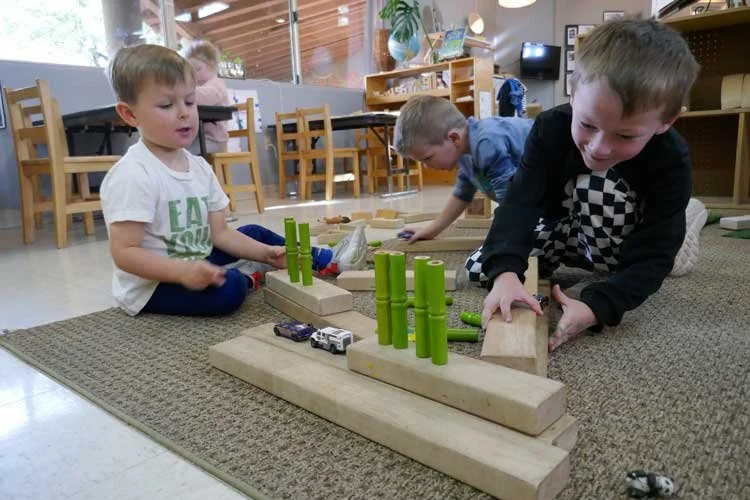How Can We Best Support Children?
Child development outlines the predictable course a child’s development will travel. However, every child walks their own path and many factors may impact an individual child’s development. Children naturally gravitate towards activities the brain deems pleasurable. By understanding where the brain naturally gravitates, it encourages parents and educators to value where a child is at while also strengthening areas for growth.
Supporting Development in Early Childhood:
Brains come online from the bottom to the top. Children cannot (and should not) be rushed in this development. We need to respect and fully meet the needs of each stage of development before moving to the next. While each area of the brain has an age range where it is most prominent, it’s important to note that young children are operating primarily from the three bottom sections of the brain (brain stem, cerebellum, and limbic) throughout early childhood.
Brain Stem (survival): Babies need loving attachment in the first six months. They are operating primarily from their survival brain and depend on a caring and responsive primary caregiver to keep them safe.
Cerebellum (movement): From six months to eighteen months, the movement brain becomes more prominent. Toddlers need freedom to move and develop their gross motor muscles. Development moves from core to shoulders, elbows, wrists, hands, and fingers. Core strength, stable joints, and bilateral coordination are essential before children should be expected to write or trace letters.
Limbic System (emotions): The emotional brain is center stage for children aged 2 to about 7 years old. This is why a social-emotional curriculum is imperative in early childhood. Children in this stage need the space and time necessary to play and develop impactful dispositions that serve as the foundation for future high-level executive functioning, such as attention span, perseverance, and self-confidence.
Frontal Cortex (higher intelligence): Typically around age 8, the frontal cortex takes on a more prominent role with executive functioning. Children at this age are ready for formal academics, with writing and numeracy taking on a larger focus. Sooner isn’t smarter and children should not be rushed into formal schooling at the expense of earlier development.
Brain research suggests gender also holds important influence and there may be key differences between how boy and girl brains typically develop. These generalizations represent what is true for the majority of data collected, not necessarily what is true for every single individual person.
In general, the minds of girls are biologically wired to support memory, sitting still, and listening from an earlier age which often results in complex learning such as reading and writing to develop easier. Girls typically have stronger neural connectors in the temporal lobe allowing for better detailed memory storage, listening skills, and discrimination of tones of voice. Another memory storage area of the brain, the hippocampus, is also larger in girl’s development which further increases girl’s advantage in traditional learning environments, especially related to the language arts. Girls are more likely to have more serotonin in the blood stream of their brain and the female prefrontal cortex is generally more active, developing at an earlier age. Both of which allow girls to make less impulsive decisions overall.
Supporting the “Girl” Brain:
Girls benefit from increased opportunities to manipulate objects, build, design and explore spatial challenges. They can be encouraged and supported as they navigate areas they are more likely to struggle with.
Girls should be encouraged to engage in physical games and large body movements.
Water and sand tables support spatial exploration and science while puzzles foster perceptual learning.
Open-ended manipulatives support math development, as well as building and construction. A variety of building materials such as wooden blocks and natural materials that are less symmetrical and more difficult to balance are a few examples.
Boys are experiential and kinesthetic learners, meaning they construct knowledge using all their senses and with their entire body. Movement helps boys stay focused. The simple act of bouncing a ball back and forth outside can support self-regulation. Boys have less serotonin and less oxytocin (the primary human bonding chemical) resulting in more physical impulses and less likely to sit still for long, empathetic chats with friends. Boys lateralize their brain activity, operating with less blood flow and their brain is structured to compartmentalize learning. As a result, they do not multitask as well, often having more issues with attention span and transitions.
Supporting the “Boy” Brain:
Greater blood flow to the cerebellum - the “doing” center of the brain - allows boys to more easily verbalize what they are doing versus how they are feeling.
For example, asking boys to describe their building in the block area, such as the steps they are taking to create it, will encourage more expansion of verbal skills. They may be more easily focused on the what of their doing, than the why. (By contrast, the “girl” brain may more easily gravitate towards imagination and storytelling).
Boys benefit from additional opportunities for fine motor development. Games using tweezers, chopsticks, and other items that encourage pincer grasps can provide support.
The male brain is designed to “renew, recharge, and reorient” by entering a rest state. As a result, boys are more likely to zone-out when more words are used to communicate. Using visual schedules and instructions that utilize pictures or symbols will be more effective.
Resources:



